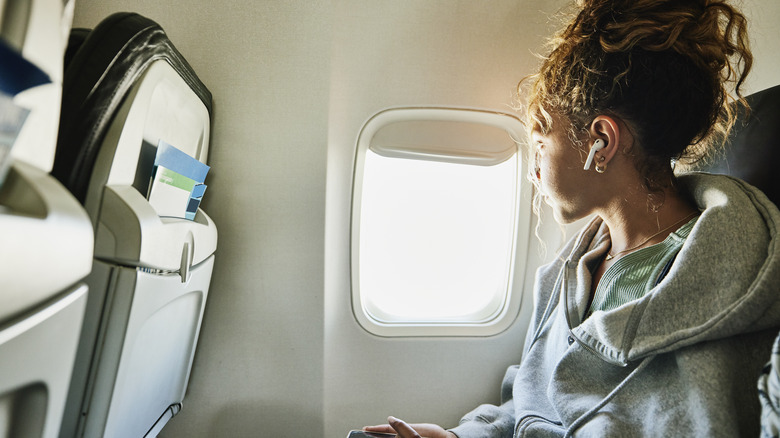Why Are Airplane Windows Round Instead Of Square?
Having round windows is usually an aesthetic choice. If you look throughout your home, most — if not all — of the windows you will have are rectangular or square. Those panes of glass with four right angles simply make for an efficient and practical way to let in sunlight while keeping out all of those pesky environmental things that can be annoying, be it wind, insects, or precipitation. If you do have a round window, it is probably a decorative piece or a singular statement at one specific place in your home. However, there is one place where you are guaranteed to see round windows, and that is an airplane. While not exactly circular or oval, the cabin of the plane is lined with rectangular windows with rounded corners.
This is a design you may have noticed every so often while glancing out at the ground from 30,000 feet or struggling with that often sticky shutter, but you probably never gave it a second thought. You are so used to the design that it becomes second nature. Unlike the windows in your home, though, this airplane window shape is not just an aesthetic choice. There is a legitimate safety reason as to why airplanes require round windows instead of square ones, much like why there is a tiny hole in the windows, too. Quite simply, if they weren't round, they would shatter.
The pressure of right angles
When you are flying in an airplane, you will come upon the phrase "a change in cabin pressure." You are inside something that is traveling hundreds of miles per hour and has to lift into the air, moving through different parts of the atmosphere. If you thought the worst part of the pressure was just making your eardrums pop, imagine the stress that the actual place deals with while making this journey. Well, it just so happens that something that does not handle that pressure very well is right angles.
Back when jet planes were first being designed, it was quickly determined that standard rectangular windows would not be sufficient in the slightest for handling this kind of pressure. The corners of these windows act as high-pressure points that would cause so much stress on the windows that they would break. The sad part is that this design was not an immediate realization, and with the de Havilland Comet jet plane, two flights in 1954 turned deadly, thanks to rectangular windows breaking. In total, 56 passengers and the flight crews died as a result.
When you have a window that is rounded, there is no specific point at which the pressure accumulates, letting it evenly disperse all the way around the window. This allows the glass to withstand all of the many pressure changes that a plane goes through during a journey, and they are able to last for a long time as well. Ideally, the safest plane has no windows, eliminating the risks entirely, but for a passenger plane, that would be rather uncomfortable.

